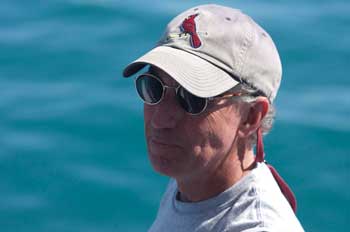Fisheries TweetChat
NOAA Fisheries Service advises mariners, right whales are on the move

Twitter Feed:
NOAA Fisheries Reminds Atlantic Coast Boaters to Be Careful
Boaters are asked to report sightings of the endangered whale and keep a distance of at least 500 yards from the protected species. Currently scientists estimate as few as approximately 360 right whales remain, making the right whale one of the most endangered
marine mammals in the world.
“Right whales are dark with no dorsal fin and they often swim slowly at or just below the water’s surface,” said Barb Zoodsma, NOAA Fisheries Service’s southeast right whale recovery program coordinator. “Many mariners mistakenly assume that because of their large size, right whales would be easy to see, but often a slight difference in texture on the water’s surface is the
only clue that a whale is present.” More...
They may be one of the biggest creatures on earth, but they sure are hard to spot from the deck of a ship. In early November, right whales are slowly making their way down the Atlantic Coast from Canada to their calving grounds in the warmer waters in the Southeast. Since these whales are one of the most endangered marine mammals in the world, there are steps that boaters - big and small - can take to ensure that this year's right whale migration is a safe one. To help mariners and the public understand more about what they can do, NOAA Fisheries is hosting a live chat on Twitter with two of the nation’s leading whale scientists.
November 17 from 1:30–2p.m. (Eastern)
@usfisheriesgov Tag with #rightwhale

Marine mammal biologist, Greg Silber, is NOAA’s National
Coordinator for Recovery Actions, particularly for endangered
large whales. He's responsible for orchestrating whale recovery
efforts nationwide, including right whales. Silber works closely with
multiple agencies, organizations and marine mammal experts
to address the issue of ship strike and gear entanglement, which
are two of the right whale's greatest threats.

Marine mammal biologist, Barb Zoodsma, is NOAA Fisheries
Southeast Right Whale Recovery Program Coordinator. Her focus
is on surveying right whales as they reach their calving grounds in
the warmer waters of the Southeast. She also helps to educate
the public about what they can do to protect right whales from ship
strike and entanglement.
Marine mammal biologist, Jamison M. Smith, serves as the
Atlantic large whale entanglement response program
coordinator for NOAA. In this role, he serves as the emergency
response point of contact for the entire U.S. eastern seaboard
for this public-private partnership, which includes fisherman and
conservationists. 
Marine mammal policy analyst, Kate Swails, is NOAA’s Atlantic
Large Whale Take Reduction Team coordinator. The take
reduction team consists of fishing industry representatives,
environmentalists, state and federal officials and other
interested parties working together to address
gear entanglement.
About Right Whales
Right whales are large baleen whales, and the second largest creature in the world - second only to the blue whale. Females are larger than males. Distinguishing features for right whales include a stocky body, generally black coloration (although some individuals have white patches on their undersides), lack of a dorsal fin, a large head (about 1/4 of the body length), strongly bowed margin of the lower lip, and callosities (raised patches of roughened skin) on the head region. Two rows of long (up to eight feet in length) dark baleen plates hang from the upper jaw, with about 225 plates on each side. The tail is broad, deeply notched, and all black with a smooth trailing edge. For more information about right whales, visit our Protected Resources website.


